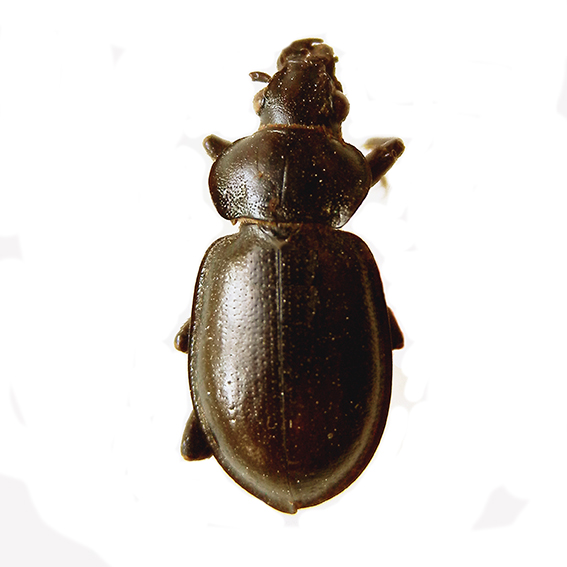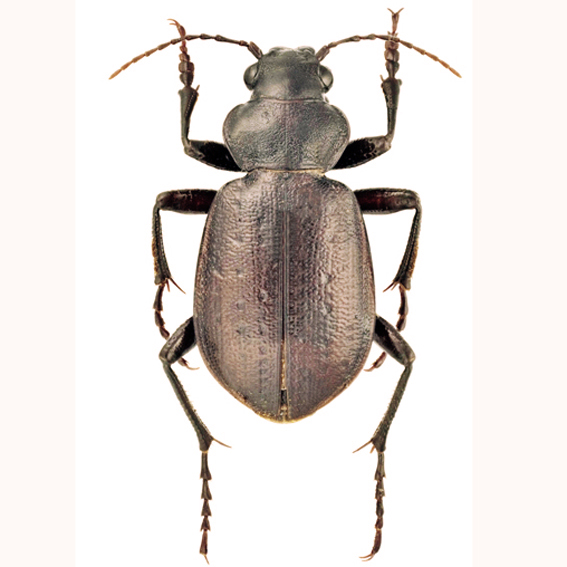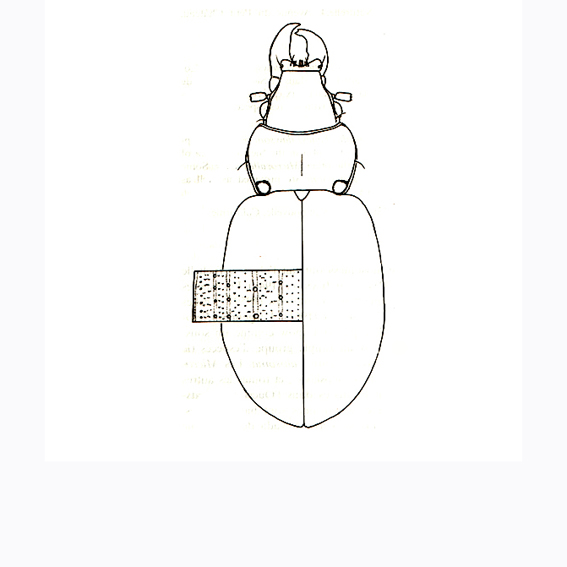Calosoma (Callistenia) subaeneum Chaudoir, 1869
C. subaeneum can be distinguished from C. latipenne with which it has been sometimes confused, by its more elongate body shape and by the elytral sculpture more detectable.
Calosoma (Callistenia) subaeneum subaeneum Chaudoir, 1869
Calosoma subaeneum Chaudoir, 1869: 28 (type material: 1 specimen given by Lorquin, from California); lectotype ♂ designated by Deuve (1978: 250) in Muséum National d'Histoire Naturelle, Paris [examined]
Calosoma (Callisthenes) subaeneum Breuning, 1928: 81
Callisthenes (Callistenia) subaenea Lapouge, 1931: 378
Microcallisthenes (Callistenia) subaeneus Jeannel, 1940: 173
Callisthenes (Microcallisthenes) subaeneus Gidaspow, 1959: 304
Callisthenes (Callistenia) subaeneus Erwin, 2007: 82
Length 17-20 mm. C. subaeneum is distinguished by its transverse pronotum, which has an almost smooth central disk, with roughness confined to the sides and the rear part. The posterior lobes of the pronotum are broadly rounded and do not project from the base.
Each elytron displays 15 distinct intervals (triploid type); the striae are marked by small punctures, and although the intervals are flat, shallow transverse wrinkles can be observed. The foveae on the primary intervals can, in some cases, be quite large.
The color of the upper body, based on the description of the only known specimen observed by Chaudoir, is described as bright black, with the sides and base of the pronotum and the entire surface of the elytra having a slightly olive-bronze hue. However, according to Gidaspow, there are specimens that exhibit a black color with a golden luster, while others are greenish-bronze.
The species appears to be rare and poorly represented in collections, and the specimen observed by Chaudoir may have been lost, which could explain some of the inconsistencies found in the lectotype.
C. subaeneum was initially described from California, with Burgess & Collins (1917: 114) later adding Idaho and Washington to its range. However, Breuning (1928b: 81) and Jeannel (1940: 173) indicated that California is the only state where C. subaeneum is confirmed to exist.
Later, Gidaspow (1959: 305) and more recently Erwin (2007: 82) revisited the distribution proposed by Burgess & Collins, suggesting a broader range for C. subaeneum from southwestern Canada (British Columbia) to California, extending through Idaho and Washington. Nonetheless, the presence of C. subaeneum in British Columbia remains uncertain, as it is based on a single, vague reference by Venables (1913: 268), later cited by Hatch (1953: 53) but questioned by Bosquet (2012: 251), who notes Lindroth's (1961: 53) skepticism.
Examined specimens and literature’s data
United States. California (type, MNHN), Fresno County (Breuning 1928b: 82): Raisin City 70m. (GBIF-CAS); Idaho (Burgess & Collins 1917: 114); Washington (Burgess & Collins 1917: 114): Okanogan County (Winthrop) 950m (www.inaturalist.org).
Notes: Brachypterous. This species is primarily nocturnal but can occasionally be observed during the day, often taking refuge in shallow cavities that it digs itself— a behavior common among many carabomorphic Calosoma. Sightings of C. subaeneum are rare, but the species appears to have a broader ecological range than previously assumed (Erwin, 2007: 82). It inhabits open lands, clearings, or forest edges at various altitudes, with its period of activity depending on the elevation. One specimen (GBIF - MCZ) was collected at approximately 2000 meters above sea level in Fresno County, though the date was unspecified. In the 1930s, numerous specimens were again collected in Fresno County, this time in lowland areas—now cultivated fields—at an altitude of 70-100 meters, from February to May. More recently, in Washington State, it was observed (www.inaturalist.org) later in the season, in July, in an artemisia steppe at an altitude of 900-1000 meters. Additionally, observations from the population near Big Alkali Lake further suggest the species' adaptability.
 Chaudoir, 1869 Californie, ex Musaeo Chaudoir (Typus) (coll. Muséum National d'Histoire Naturelle, Paris) |
 Chaudoir, 1869 (photo: Mackenzie Flight) |
Calosoma (Callistenia) subaeneum dawsoni (Dajoz, 1997)
Callisthenes (Microcallisthenes) dawsoni Dajoz, 1997:70 (type locality: California, Mono county) type material: 19 specimens, no repository given
Callisthenes (Callistenia) dawsoni Erwin, 2007: 76
Length 15-16 mm. An allegedly new species, Callisthenes (Microcallisthenes) dawsoni Dajoz, 1997, described based on fewer than twenty specimens, was compared by the author to C. moniliatum, with which it is said to share similarities in its elongated shape and the brilliant or dark bronze color of its upper body.
However, based on the original description, it appears more closely related to C. subaeneum due to its elongated body shape and bronze upper body coloration.
This resemblance is further supported by the elytral sculpture, which, as in C. subaeneum, features striae marked by shallow punctures and flat intervals, with the primary intervals displaying large, metallic green blue foveae.The species' penis has an elongated apex, and the ligula is thin with a curved tip, as is common in many species of the subgenus.
In conclusion, given the lack of additional specimens, it seems more likely that C. dawsoni represents an ecologically isolated population of C. subaeneum with minor morphological differences, such as more pronounced coloration and slightly smaller size.
Examined specimens and literature’s data
United States: California: Mono County, Big Alkali Lake, (road between Mammoth Lake and Benton), 2100 m. (Dajoz, 1997: 70)
Notes: The type series originates from the Sierra Nevada in California, specifically in Mono County. The specimens were collected under unique ecological conditions on the shores of Big Alkali Lake, near the road connecting Mammoth Lake and Benton, at an altitude of 2,100 meters in August. No other occurrences of this taxon are known.
The species was named in honor of Daniel R. Dawson, who was the director of the Sierra Nevada Aquatic Research Laboratory at the time. He played a key role in facilitating the research that led to the discovery of this new Calosoma species.
 (Dajoz, 1997) Dajoz R. (1997) "Description et biologie d’un Callisthenes nouveau de la Sierra Nevada de Californie (Coleoptera: Carabidae)", Nov. Revue Ent. (N. S.), T. 14, Fasc. 1: 70 |